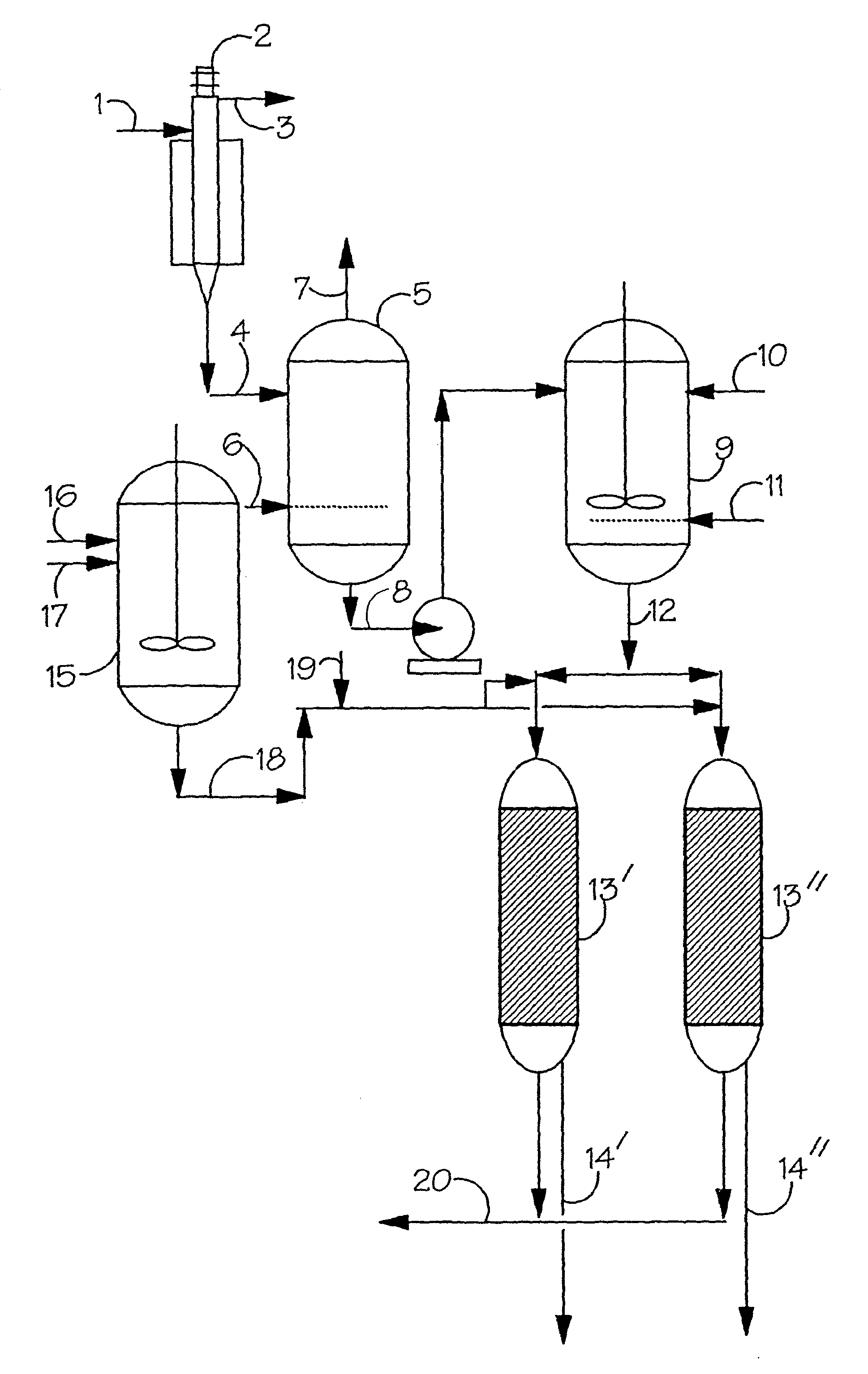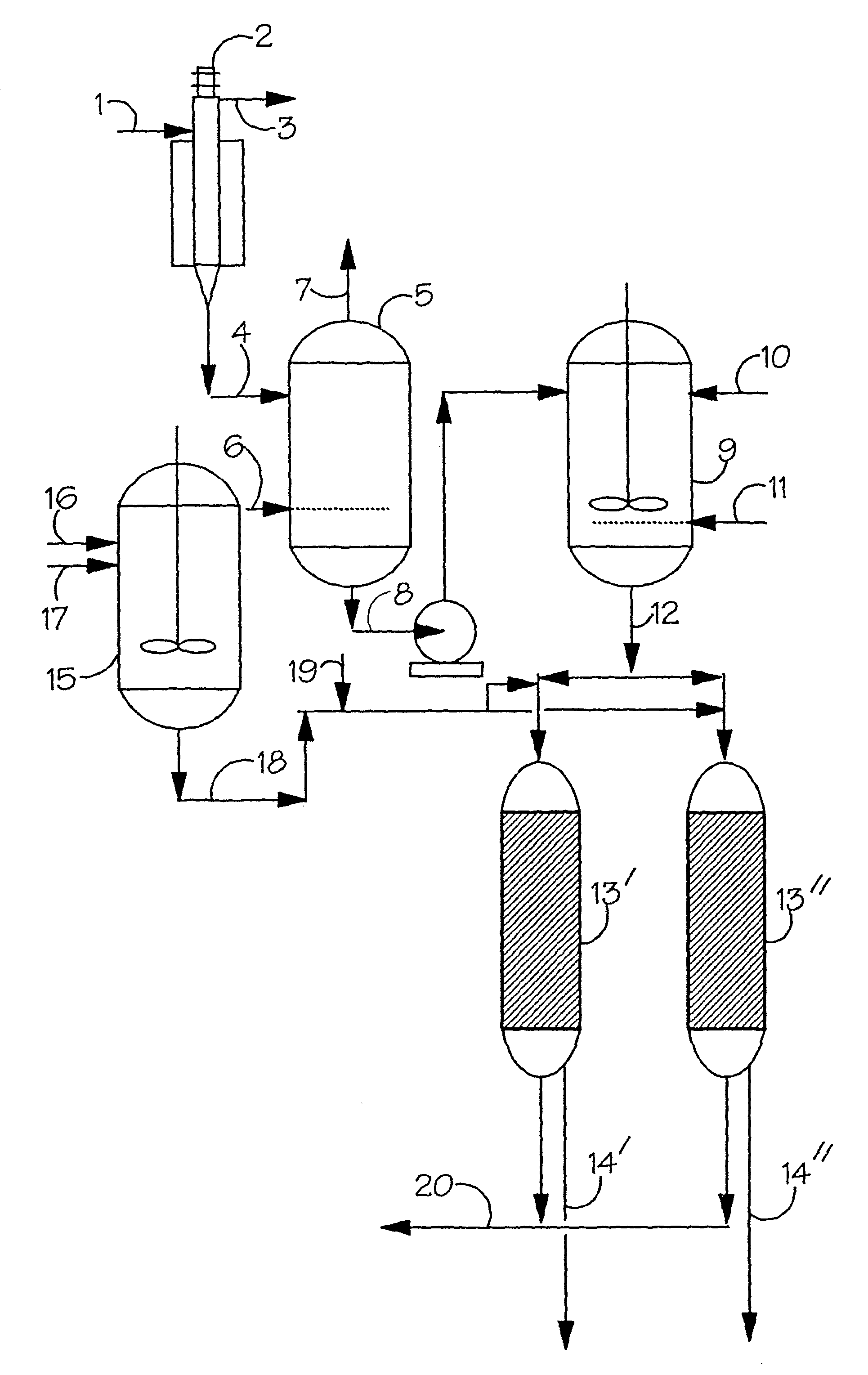Process for recovering homogeneous metal hydride catalysts
- Summary
- Abstract
- Description
- Claims
- Application Information
AI Technical Summary
Benefits of technology
Problems solved by technology
Method used
Image
Examples
example 1
[0092]The ability of the Amberlyst DPT-1 to reversibly remove rhodium from an octene hydroformylation reactor solution was investigated using a solution containing 175 ppm rhodium and 10 wt % triphenylphosphine in a solution containing 28 g octene-1 and 52 g toluene. The octene was first converted to nonanal by hydroformylation at 85° C. and 85 psig with 1:1 hydrogen / carbon monoxide with measurement of the gas uptake. 25 ml dry volume of washed and dried Amberlyst DPT-1 was soaked in a solution containing 10 wt % triphenylphosphine in toluene and then filtered. After the octene hydroformylation was shown to be complete by cessation of discernable gas uptake the solution was cooled and the wet resin added to the autoclave. The mixture was then heated to 85° C. for one hour and the liquid drained from the resin. Analysis showed that the rhodium concentration in solution had fallen to 14 ppm. 50 ml of 10 wt % triphenylphosphine in toluene was added to the resin remaining in the reactor...
example 2
[0093]The effect of poisons on the recovery of hydroformylation catalyst was investigated using a solution containing 175 ppm rhodium and 10 wt % triphenylphosphine in a solution containing 28 g octene-1, 52 g toluene and 1 ml of ethyl sorbate. The octene was first converted to nonal by hydroformylation at 85° C. and 85 psig with 1:1 hydrogen / carbon monoxide with measurement of the gas uptake. From the rate of gas uptake it was calculated that the rhodium had only 50% the activity that would be expected in the absence of poisons and inhibitors. 25 ml dry volume of washed and dried Amberlyst DPT-1 was soaked in a solution containing 10 wt % triphenylphosphine in toluene and then filtered. After the octene hydroformylation was shown to be complete by cessation of discernable gas uptake the solution was cooled and the wet resin added to the autoclave. The mixture was then heated to 85° C. for one hour and the liquid drained from the resin. Analysis showed that the rhodium concentration...
example 3
[0094]The effect of hydrogen pressure on the concentration of the hydroformylation catalyst in solution was investigated using 200 ml of a solution containing 570 ppm rhodium and 10 wt % triphenylphosphine in octene-1. First the solution was gradually heated up to 85° C. and 85 psig 1:1 hydrogen / carbon monoxide until hydroformylation was complete. After cooling, 50 ml of washed and dried Amberlyst DPT-1 was added to the reactor and warmed to 95° C. with stirring. After heating at 95° C. for 4 hours the solution was removed and the rhodium concentration was determined to be 18 ppm. 100 ml of 10 wt % triphenylphosphine in toluene was then added to the autoclave and stirred at 40° C. and 500 psig of hydrogen for 16 hours. A sample taken from the reactor after this time contained 330 ppm rhodium. The pressure in the autoclave was then released and the temperature increased to 70° C. After 2 hours a sample was taken and analysed and found to contain 24 ppm rhodium. The pressure in the au...
PUM
| Property | Measurement | Unit |
|---|---|---|
| Temperature | aaaaa | aaaaa |
| Temperature | aaaaa | aaaaa |
| Temperature | aaaaa | aaaaa |
Abstract
Description
Claims
Application Information
 Login to View More
Login to View More - Generate Ideas
- Intellectual Property
- Life Sciences
- Materials
- Tech Scout
- Unparalleled Data Quality
- Higher Quality Content
- 60% Fewer Hallucinations
Browse by: Latest US Patents, China's latest patents, Technical Efficacy Thesaurus, Application Domain, Technology Topic, Popular Technical Reports.
© 2025 PatSnap. All rights reserved.Legal|Privacy policy|Modern Slavery Act Transparency Statement|Sitemap|About US| Contact US: help@patsnap.com



